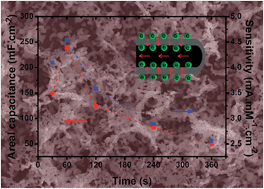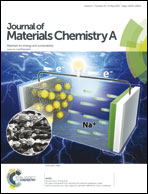Hierarchical porous Ni/NiO core–shells with superior conductivity for electrochemical pseudo-capacitors and glucose sensors†
Abstract
Although the NiO nanostructures potentially hold outstanding electrochemical activity in theory, dual enhancements in both electrical conductivity and electrolyte transport are two challenging issues for designing high performance electrodes. In this work, hierarchical porous Ni/NiO core–shells are synthesized. The interconnected Ni skeletons with favorable electrical conductivity are uniformly covered by the continuous NiO scarfskins that hold both high energy storage capacity and efficient catalysis. The hierarchical porous Ni/NiO electrode exhibits superior pseudo-capacitive performance evidenced by an areal capacitance up to 255 mF cm−2. Meanwhile, this conductive electrode also exhibits electrocatalytic activity for glucose oxidation with a sensitivity of 4.49 mA mM−1 cm−2 and a reliable detection limit of 10 μM. On the other hand, hierarchical porosities enhance the effective transport of electrolytes and ions within the interconnected porous channels, making dramatic contributions to a superior storage stability of 4000 cycles and prompt an amperometric response time of 1.5 s. These concepts of the hierarchical metal–metal oxide core–shell open an avenue to design high-performance materials for energy storage and electrochemical catalysis.


 Please wait while we load your content...
Please wait while we load your content...